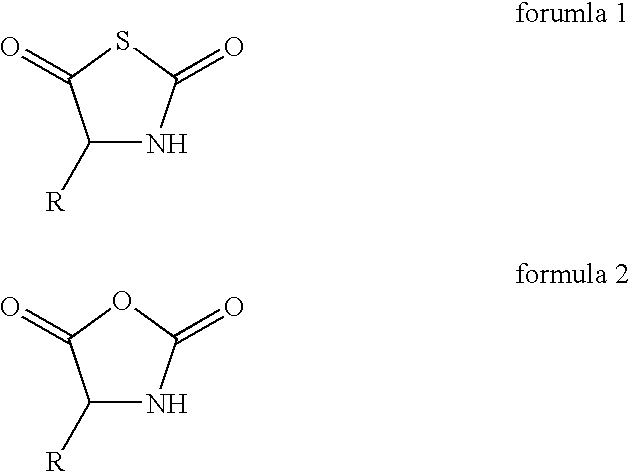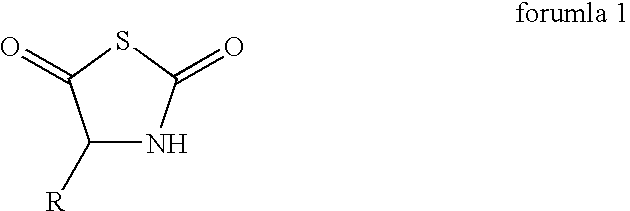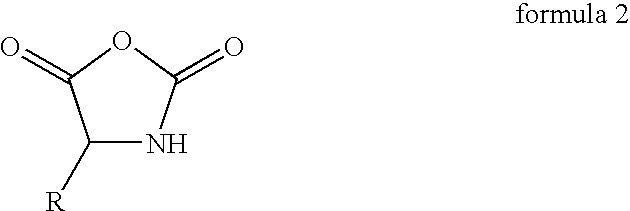Process for the preparation of a polypeptide
a polypeptide and polypeptide technology, applied in the field of polypeptide preparation, can solve problems such as inability to ensure, and achieve the effect of desirable molecular weight and ratio of different amino acids
- Summary
- Abstract
- Description
- Claims
- Application Information
AI Technical Summary
Benefits of technology
Problems solved by technology
Method used
Image
Examples
example 1
Fully Protected Copolymer-1 Preparation
[0043]0.166 g of N-thiocarboxyanhydride of L-alanine, 0.111 g of N-carboxyanhydride of gama-benzyl L-glutamate, 0.303 g of N-carboxyanhydride of e-N-benzyloxycarbonyl L-lysine, and 0.060 g of N-carboxyanhydride of L-tyrosine were dissolved in 8.1 ml of dioxane to which 3.3 ml of diethyl amine in dioxane (0.5 g / L) was added. The reaction mixture was stirred at room temperature for 48 hours. The reaction mixture was poured into 50 ml of water with good agitation. The white precipitation was filtered and washed subsequently with water and acetone. After drying in vacuum, 0.427 g (85.4% yield based on the total weight) of fully protected polypeptide was obtained.
example 2
Copolymer-1 Preparation by Acidolysis
[0044]0.200 g of protected polypeptide obtained by the method described in Example 1) was added to 10 ml of 40% hydrobromic acid dissolved in acetic acid and stirred at 30° C. for 16 hours. 0.181 g of crude product was precipitated from the reaction mixture by adding 30 ml of ethyl ether. 0.050 g of crude product was dissolved in 1 ml of 1 N aqueous acetic acid and then was loaded on a Sephadex G50 (2.8×32 cm) column which was equilibrated and eluted with 1 N acetic acid. The elution between 58˜105 ml was collected and dried in vacuum to give 20.2 mg of copolymer-1 acetate with a yield of 47% calculated based on the weight of starting material.
example 3
Copolymer-1 Preparation by Combination of Base Cleavage with Acidolysis
[0045]0.200 g of protected polypeptide obtained by the method described in Example 1 was dissolved in 3 ml of dimethyl formamide and 0.25 ml of 5 N aqueous NaOH solution was added. After being stirred at 25° C. for 2 hours, the reaction solution was neutralized to pH 7 by adding 3 ml of 1 N aqueous HCl solution in ice bath and then diluted with 10 ml of water to obtain 0.176 mg of precipitant. All the dried precipitant was added to 5 ml of 40% hydrobromic acid dissolved in acetic acid and stirred at 30° C. for 4 hours. 0.182 g of crude product was precipitated from the reaction mixture by adding 30 ml of ethyl ether). 0.090 g of crude product was dissolved in 1 ml of 1 N aqueous acetic acid and then was loaded on a Sephadex G50 (2.8×32 cm) column which was equilibrated and eluted with 1 N acetic acid. The elution between 58˜105 ml was collected and dried in vacuum to give 16.1 mg of copolymer-1 acetate with a yie...
PUM
| Property | Measurement | Unit |
|---|---|---|
| molar ratio | aaaaa | aaaaa |
| molar ratio | aaaaa | aaaaa |
| molar ratio | aaaaa | aaaaa |
Abstract
Description
Claims
Application Information
 Login to View More
Login to View More - R&D
- Intellectual Property
- Life Sciences
- Materials
- Tech Scout
- Unparalleled Data Quality
- Higher Quality Content
- 60% Fewer Hallucinations
Browse by: Latest US Patents, China's latest patents, Technical Efficacy Thesaurus, Application Domain, Technology Topic, Popular Technical Reports.
© 2025 PatSnap. All rights reserved.Legal|Privacy policy|Modern Slavery Act Transparency Statement|Sitemap|About US| Contact US: help@patsnap.com



